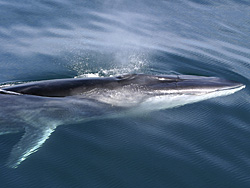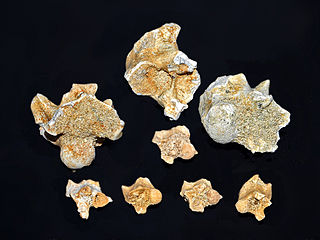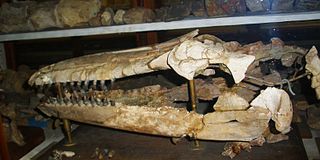Related Research Articles

Platanistidae is a family of river dolphins containing the extant Ganges river dolphin and Indus river dolphin but also extinct relatives from marine deposits in the Neogene.

Balaenoptera, from Latin: balaena ('whale') and Ancient Greek: pteron ('fin'), is a genus of rorquals, and contains eight extant species. Balaenoptera comprises all but two of the extant species in its family ; the genus is currently polyphyletic, with the two aforementioned species being phylogenetically nested within it.

Palaeophis is an extinct genus of marine snake that is the type genus of the extinct snake family Palaeophiidae.

Allopleuron is a genus of extinct sea turtle, which measured 2-to-2.5-metre long in life. The type species is Allopleuron hofmanni. It is a basal member of the clade Pancheloniidae, closely related to Protosphargis. Similar to Protosphargis, it was characterized by shell reduction.

Carcharias is a genus of sand tiger sharks belonging to the family Odontaspididae. Once bearing many prehistoric species, all have gone extinct with the exception of the critically endangered sand tiger shark.
Hyposaurus is a genus of extinct marine dyrosaurid crocodyliform. Fossils have been found in Paleocene aged rocks of the Iullemmeden Basin in West Africa, Campanian–Maastrichtian Shendi Formation of Sudan and Maastrichtian through Danian strata in New Jersey, Alabama and South Carolina. Isolated teeth comparable to Hyposaurus have also been found in Thanetian strata of Virginia. It was related to Dyrosaurus. The priority of the species H. rogersii has been debated, however there is no sound basis for the recognition of more than one species from North America. The other North American species are therefore considered nomina vanum.

Lunaspis is an extinct genus of armor-plated petalichthyid placoderm fish that lived in shallow marine environments of the Early Devonian period, from approximately 409.1 to 402.5 million year ago. Fossils have been found in Germany, China and Australia. There are three different identified species of within the genus Lunaspis: L. broilii, L. heroldi, and L. prumiensis.

Campylocephalus is a genus of eurypterid, a group of extinct aquatic arthropods. Fossils of Campylocephalus have been discovered in deposits ranging from the Carboniferous period in the Czech Republic to the Permian period of Russia. The generic name is composed of the Greek words καμπύλος (kampýlos), meaning "curved", and κεφαλή (kephalē), meaning "head".

Araripichthys is an extinct genus of prehistoric ray-finned fish that lived from the Aptian to Coniacian stages of the Cretaceous period. The genus is named after the Araripe Basin, where it was found in the Crato and Santana Formations. Other fossils of the genus have been found at Goulmima in Morocco, the Tlayua Formation of Mexico and the Apón Formation of Venezuela.
Chongichthys is an extinct genus of prehistoric bony fish that lived during the Oxfordian stage of the Late Jurassic epoch. Fossils of the genus have been found in the Quebrada El Profeta of Chile.

Chelonoidis is a genus of turtles in the tortoise family erected by Leopold Fitzinger in 1835. They are found in South America and the Galápagos Islands, and formerly had a wide distribution in the West Indies.

Thalattoarchon is an extinct genus of ichthyosaur from the Middle Triassic of the western United States. The type species Thalattoarchon saurophagis was discovered in Nevada, USA, in 2010 and formally described in 2013. It is known from a single skeleton, holotype FMNH PR 3032, consisting of a partial skull, vertebral column, hip bones, and parts of the hind fins. The total length of Thalattoarchon is estimated to have been at least 8.6 metres (28 ft). Thalattoarchon is thought to have been one of the first marine macropredators capable of eating prey that was similar in size to itself, an ecological role that can be compared to that of modern orcas. Thalattoarchon lived four million years after the first appearance of ichthyosaurs in the Early Triassic and is therefore the oldest known marine reptile to have been an apex predator. It lived eight million years after the Permian-Triassic extinction event, indicating a fast recovery of marine ecosystems after the mass extinction.

Hemisyntrachelus is an extinct genus of cetacean.

Pholadomya is a genus of saltwater clams, marine bivalve molluscs in the family Pholadomyidae.

Neotrigonia margaritacea, common name the pearly brooch-shell, is a species of saltwater clam, a marine bivalve mollusc in the family Trigoniidae. This species is known from sandy substrates in shallow seas in southeastern and southwestern Australia. This species was the first member of the family to be discovered alive; previous to its discovery, trigoniids were only known from fossils.
Muiscasaurus is an extinct genus of ophthalmosaurid Ichthyosaur that lived in modern Colombia during the Early Cretaceous. The only known species is the type Muiscasaurus catheti.

Leyvachelys is an extinct genus of turtles in the family Sandownidae from the Early Cretaceous of the present-day Altiplano Cundiboyacense, Eastern Ranges, Colombian Andes. The genus is known only from its type species, Leyvachelys cipadi, described in 2015 by Colombian paleontologist Edwin Cadena. Fossils of Leyvachelys have been found in the fossiliferous Paja Formation, close to Villa de Leyva, Boyacá, after which the genus is named. The holotype specimen is the oldest and most complete sandownid turtle found to date.

Miocochilius is an extinct genus of small notoungulate mammals (typotheres) native to South America. The genus lived during the Middle Miocene epoch. The genus contains two described species, the type species M. anomopodus described in 1953 by Ruben Arthur Stirton and M. federicoi, described and included in the genus by Darin A. Croft.
Uintasorex is a genus of primate which lived in North America during the Eocene epoch. Fossils belonging to Uintasorex have been dated to the Bridgerian and Uintan stages, roughly 50.3 to 42 million years ago.

Aquilolamna is an extinct genus of shark-like elasmobranch from the Late Cretaceous (Turonian)-aged Agua Nueva Formation of Mexico. It is currently known to contain only one species, A. milarcae, also known as the eagle shark, and it is classified in its own family Aquilolamnidae, which has been tentatively assigned to the mackerel sharks.
References
- 1 2 Sepkoski, Jack (2002). "A compendium of fossil marine animal genera (Trilobita entry)". Bulletins of American Paleontology. 364: 560. Archived from the original on September 5, 2006. Retrieved 2008-01-12.
- ↑ "Fossilworks: Komaspidella". fossilworks.org. Retrieved 17 December 2021.
- ↑ U.S. Geological Survey Professional Paper. U.S. Government Printing Office. 1960.